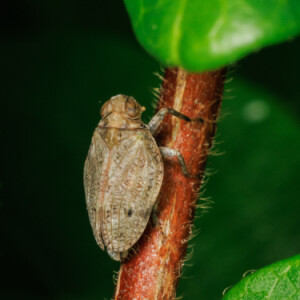Serendipity
As I walked back to the house this morning after a trip down the garden to put some kitchen refuse on the compost heap, I wondered what on earth I was going to find to photograph on such a dark, cold, dank day. But there on the back wall, right by the kitchen door at pretty much head height, was a planthopper. It couldn't have made itself much more obvious if it had been waving a football rattle.
"Good grief!" I said. "Whatever are you doing there?" And then, "Don't move! I'll be right back!"
Having kicked off my shoes, run upstairs, grabbed the camera, slithered back down the stairs while setting the flash, and hopped back out onto the patio, shoeless, I was relieved and surprised to find the bug still in the same place. Issus coleoptratus is flightless, but it can jump around 30cm when threatened, and it can hardly have failed to notice that it was suddenly the object of scrutiny by a potential predator. Nevertheless, there it stayed, while I photographed it from every angle I could think of.
As I turned off the camera I thanked it for the photos and suggested respectfully that it really ought to think about going somewhere more sheltered. "I can move you if you like," I said. "Shall I fetch a bug pot?" There was no reply. "Well, think about it," I said, "and let me know." Then I went back into the kitchen and carried on making bread. The next time I stuck my head out of the back door to check on it, the hopper was walking slowly and determinedly up the wall, and was now about ten feet above the ground. "What can I do?" I wailed to R. "It's too high for me to reach now, and it surely can't survive on a cold wall. And it takes them two years to reach adulthood!" "Wow," he replied, in a humouring kind of voice. "That's a lot of commitment."
Over the next couple of hours the climb went on, and the route the hopper was taking appeared to have it on a collision course with a large spider. Game over, I thought. I hardened my heart and reminded myself that it's all about the survival of the fittest, and the spider has at at least as much right to thrive as the bug does, &c., &c. But then, half way through the afternoon, I stepped outside again to go to the garage, and was amazed to find my little friend back at the side of the door. I gave a little whoop and went and fetched a bug pot, into which the hopper obligingly hopped.
"Where shall I put you?" I asked it. "On the ivy?" It didn't respond, but I decided on the ivy anyway - partly because I know from reading articles like this that Issus coleoptratus has a special relationship with ivy, but mainly because all but one of the specimens I've ever found in my garden have emerged from the ivy on our boundary fence. But despite all my efforts to persuade it onto the plant, the bug declined to leave the pot: ivy, it appeared, was not the flavour of the day. "OK then," I said. "In that case I suppose we'd better try the honeysuckle." I'm happy to report that this site met with more favour, and my second photo shows my final view of the hopper as it wandered away into the depths of the climber.
There's a lot that still isn't properly understood about this species, and one of the unknowns is whether or not adult specimens are able to overwinter, as the nymphs are known to do. So I can't say if this individual was looking for somewhere to hibernate when it turned up at the door this morning. But I'm certain it wouldn't have survived either inside the house or exposed on a cold, rendered wall, and I'm glad that I was able to move it to a place where it will be able to shelter and hide.


Comments
Sign in or get an account to comment.


